Bhimbetka Caves
Friday 14 January - Saturday
15 January 2000
From monuments to bird spotting
to rock paintings, our next stop was Bhopal, the capital of the Central Madhya
Pradesh region of India. We left
Bharatpur by bus and headed back to Agra, then caught a train south and what
felt like days later, arrived in Bhopal. It
was rarely on many travellers’ itinerary, but we had come with a specific
objective in mind: to visit the Bhimbetka caves.
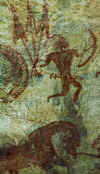 Among forests of teak and craggy
cliffs about 50 kilometres (30 miles) south of Bhopal, thousands of rock shelters have been found
containing ancient paintings depicting the life and times of the different
people who lived here. The colours
have been remarkably well-preserved thanks to the natural red and white pigments
used by the painters, and everything from figures of buffalo, bear and tigers to
hunting scenes, dancing and religious rites can clearly be made out.
The oldest paintings are thought to be around 12,000 years old and they
are intriguing to see. The setting
was somewhat eerie: wind howling through the caves, mist obscuring views of the
surrounding landscape, and a feeling of total desolation (we were the
only people there).
Among forests of teak and craggy
cliffs about 50 kilometres (30 miles) south of Bhopal, thousands of rock shelters have been found
containing ancient paintings depicting the life and times of the different
people who lived here. The colours
have been remarkably well-preserved thanks to the natural red and white pigments
used by the painters, and everything from figures of buffalo, bear and tigers to
hunting scenes, dancing and religious rites can clearly be made out.
The oldest paintings are thought to be around 12,000 years old and they
are intriguing to see. The setting
was somewhat eerie: wind howling through the caves, mist obscuring views of the
surrounding landscape, and a feeling of total desolation (we were the
only people there).
The other interesting discovery
we made back in Bhopal was the old Union Carbide plant, closed down after the
1984 toxic leak which killed over 16,000 people in the city.
The site of this multinational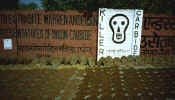 US-based company is now a graveyard. Barbed
wire fencing and vast brick walls encircle its perimeters and there are now
memorial statues dedicated to the many people who died.
Despite receiving $470 million in compensation, the Indian government has
yet to share this money with the people of Bhopal who suffered, and the
slogans painted on any available surface leave you in no doubt that sentiment is
still running high in the bid to find a scapegoat for this appalling tragedy.
US-based company is now a graveyard. Barbed
wire fencing and vast brick walls encircle its perimeters and there are now
memorial statues dedicated to the many people who died.
Despite receiving $470 million in compensation, the Indian government has
yet to share this money with the people of Bhopal who suffered, and the
slogans painted on any available surface leave you in no doubt that sentiment is
still running high in the bid to find a scapegoat for this appalling tragedy.
Sanchi
Sunday 16 January 2000
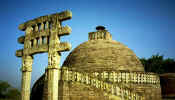 From Bhopal, we hired a car and
driver and headed east to the town of Sanchi, which houses some of the
oldest and most interesting Buddhist structures in India.
The first stupas here were built in the 3rd century BC, and
over the succeeding centuries, many other religious structures were added.
From Bhopal, we hired a car and
driver and headed east to the town of Sanchi, which houses some of the
oldest and most interesting Buddhist structures in India.
The first stupas here were built in the 3rd century BC, and
over the succeeding centuries, many other religious structures were added.
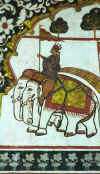 We arrived
in Sanchi by late
afternoon. It’s a small town with
few options on accommodation (the so-called hotels could hardly warrant such an
ambitious title) and by the time we had arrived, everything was full.
Our only remaining hope was to get a room at the local Buddhist
monastery, which consisted of a mattress and cold running water.
Food options were equally limited so dinner was a packet of biscuits and
while Eric ran off to capture sunset at the monuments, Pippa hunkered down with
a Pepsi-Cola for the night, dreaming of five-star luxuries like hot water and
fresh green salads.
We arrived
in Sanchi by late
afternoon. It’s a small town with
few options on accommodation (the so-called hotels could hardly warrant such an
ambitious title) and by the time we had arrived, everything was full.
Our only remaining hope was to get a room at the local Buddhist
monastery, which consisted of a mattress and cold running water.
Food options were equally limited so dinner was a packet of biscuits and
while Eric ran off to capture sunset at the monuments, Pippa hunkered down with
a Pepsi-Cola for the night, dreaming of five-star luxuries like hot water and
fresh green salads.
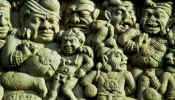 The next morning, we wandered
through the temple complex, admiring the bizarre structures and stunning stone
carvings. While Sanchi played no
part in the life of Buddha, it is attributed to Emperor Ashoka, supporter and defender
of the Buddhist faith, who was responsible for taking the teachings of the
Enlightened One to Sri Lanka. The
most significant element of Buddhist architecture is the stupa and Sanchi has
several fine examples, some encircled by an outer wall or even a terrace with a
flight and steps with balustrades leading up to it.
The next morning, we wandered
through the temple complex, admiring the bizarre structures and stunning stone
carvings. While Sanchi played no
part in the life of Buddha, it is attributed to Emperor Ashoka, supporter and defender
of the Buddhist faith, who was responsible for taking the teachings of the
Enlightened One to Sri Lanka. The
most significant element of Buddhist architecture is the stupa and Sanchi has
several fine examples, some encircled by an outer wall or even a terrace with a
flight and steps with balustrades leading up to it.
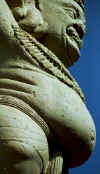
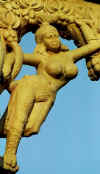 Sanchi is one of the
best-preserved sites in India and the quality of its monuments was indeed
superior to many others we had seen. There
were several fine examples of yakshas (pot-bellied spirits) and yakshis (tree nymphs) which supported the architraves of each of the four
gateways, and referred to important moments in the Buddha’s life.
Elephants also featured prominently as it was an elephant who brought
news of Buddha’s birth to his mother in a dream.
The level of detail in the carvings was exquisite, and it was amazing how
much time we spent simply wandering through the smallish complex, admiring the
architecture and snapping photos.
Sanchi is one of the
best-preserved sites in India and the quality of its monuments was indeed
superior to many others we had seen. There
were several fine examples of yakshas (pot-bellied spirits) and yakshis (tree nymphs) which supported the architraves of each of the four
gateways, and referred to important moments in the Buddha’s life.
Elephants also featured prominently as it was an elephant who brought
news of Buddha’s birth to his mother in a dream.
The level of detail in the carvings was exquisite, and it was amazing how
much time we spent simply wandering through the smallish complex, admiring the
architecture and snapping photos.
By late afternoon, we were
heading for the train station to pick up another train, this time heading back
north to Jhansi, a convenient transit point to both Orchha and Khajuraho, our
two next destinations.